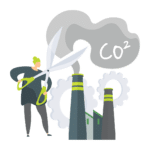The container glass industry plays an essential role in supplying a diverse range of brands with healthy, reusable and infinitely recyclable closed loop packaging. To continue to make glass packaging fit for Europe’s future, we must address its emissions.
Today, dozens of initiatives are already underway across Europe to reduce glass’s carbon footprint and achieve net zero emissions by 2050. Supported by all FEVE member companies, our 2024 decarbonisation report describes how our industry is progressing on making net zero container glass production a reality.

Our industry is investing in a wide range of state-of-the-art furnace technologies – collectively known as the ‘Furnaces of the Future’ – to take advantage of all these energy pathways and enable low-carbon glassmaking. These range from all-electric melting furnaces, to green hydrogen production, to innovative ‘hybrid furnace’ technologies that replace a proportion of natural gas with renewable energy.

Glass is a ‘permanent material’ that doesn’t lose quality when recycled, but market demand for recycled glass cullet exceeds its availability. To reverse this trend, we’ve teamed up with key players in the glass value chain and launched the “Close the Glass Loop” initiative to collect more and better recycled glass packaging. We also invest in optimised collection, sorting and recycling technologies to bring more cullet back into production.

Today’s glass bottles, jars and flacons are stronger and lighter than ever before, and designed with their carbon footprint in mind. Manufacturers are decreasing the average weight of container designs to minimise raw materials needed for production and reduce emissions during transit. These containers are also being made from more and more recycled glass and increasingly from lower carbon alternative raw materials – a sign of the collective efforts of the entire industry to decarbonise.

To reduce emissions from delivery vehicles and fleets as part of our overall Scope 3 emissions, manufacturers across the industry are working with their customers to undertake a range of decarbonisation initiatives, from increasing the use of rail routes to trialling and integrating low carbon delivery vehicles into their transport fleets, including the use of alternative fuel sources.
Read more
Invested into energy efficiency and decarbonisation projects each year
Of container glass production in Europe is covered by SBTI targets
Of glass containers collected for recycling in Europe (2022)
Make low-carbon energy accessible by decreasing the cost of grid connection; incentivising authorities to increase financial support for glassmakers switching to renewable energy; and investing in the necessary infrastructure.
Improve glass collection infrastructure through investment into municipal glass collection systems; educating customers on how to prepare their glass for recycling; and campaigns to raise awareness of bottle bank locations.
Make sustainable design choices to increase the amount of recycled content in glass containers, and follow lightweighting principles to reduce weight and volume without compromising on brand aesthetic.
Identify lower-carbon transport options, like vehicles that run on-low carbon energy and alternative modes of transport (such as trains and ships), and obtain grants, subsidies or tax breaks for companies investing in them.
Read more
On this basis, a number of national glass associations have produced national roadmaps outlining the strategy for a decarbonised industry:
European countries’ national roadmaps show that the trajectory for low-carbon glass is progressing. However, increasing this investment requires substantial funding, and further advances will depend on whether continued investment and enabling conditions are put in place by policymakers. Technological breakthroughs are expensive, and our industry is no exception. Installing electric or hybrid furnaces, using hydrogen and/or biofuels, or implementing carbon capture utilisation and sequestration across Europe will require significantly higher capital and operational expenditure.
Now, to accelerate progress on decarbonisation, we need public authorities and customers to support us in putting the right enabling conditions in place. As the trajectory for low-carbon glass progresses, industry investment in new technologies and infrastructure will need to continue to rise.
Family-owned spirits giant Bacardi is committed to leading the drinks industry in environmental best practices, by investing in innovative new technologies and exploring opportunities to decarbonise their operations at every stage of their production process. This is not just about the sustainable sourcing of ingredients or transitioning to clean energy – it also means choosing to package their products in glass. That’s why Bacardi chose to partner with the glass manufacturer Hrastnik1860 to trial hydrogen-fuelled glass production.
Ardagh Glass launches construction on a groundbreaking hybrid furnace at its glass production facility in Obernkirchen, Germany – designed to generate a significant reduction in CO2 emissions, by as much as 60% in the furnace. The move marks a key milestone for the glass industry’s goal of decarbonising glass production across Europe.
For more than 100 years, O-I has been innovating and transforming the glass packaging industry. Their current ambition? To reinvent and reimagine glass-making so the circularity of glass meets the potential of MAGMA melting technology, lowcarbon alternative fuels, and light-weighted glass packaging.